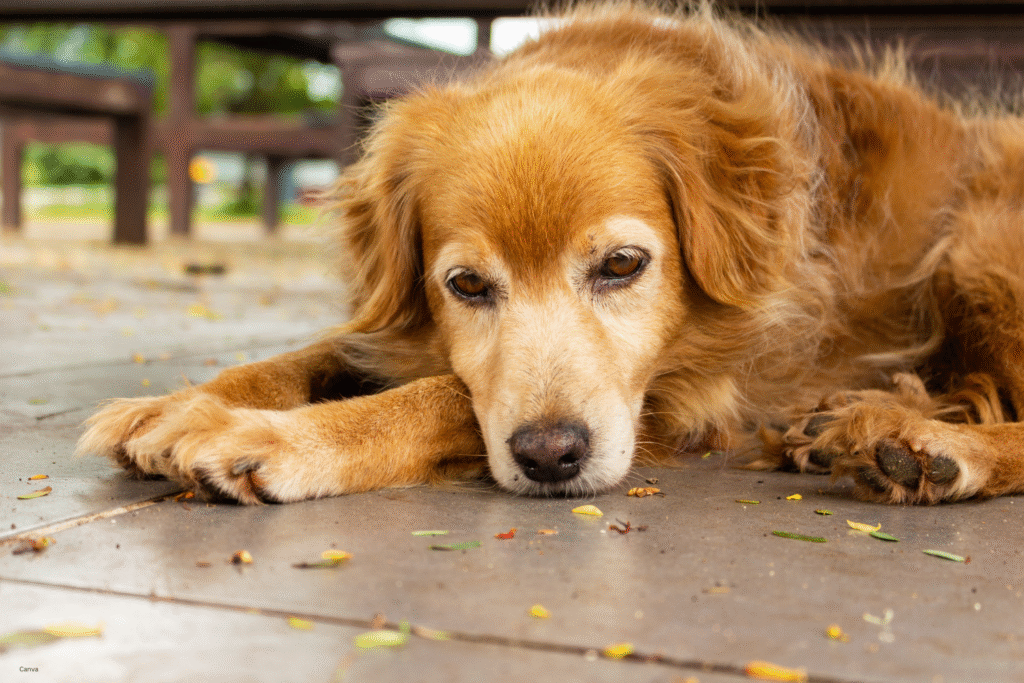Some behaviors look normal until you realize they’re quiet cries for help.

Dogs are experts at hiding emotional struggles, often masking their discomfort behind small shifts in habits that are easy to miss. That wagging tail doesn’t always mean happiness, and subtle changes can point to deeper problems. Knowing how to read the signs helps you step in before your dog’s low mood becomes a long-term problem. These nine behaviors often appear when dogs are feeling down, even if everything else seems normal on the surface.
1. Sudden disinterest in favorite activities raises red flags.

A dog ignoring a favorite toy or skipping a once beloved walk is rarely just bored. According to the American Kennel Club, loss of interest in previously exciting activities is a strong sign of depression in dogs. It often happens after major life changes like moving, the loss of a companion, or even subtle shifts in the household routine.
This disinterest is a behavioral way of checking out emotionally, similar to how humans can lose enthusiasm when stressed or sad. The change can show up gradually or seem to happen overnight, leaving owners wondering what went wrong. Dogs live for enrichment and play, so when they stop seeking it out, it’s a signal worth taking seriously. Bringing back routine, adding new challenges, and spending more intentional time together often helps pull them out of this emotional slump.
2. Shifts in appetite tell a bigger story than you think.

Food is a big part of a dog’s life, so when eating habits change, it’s rarely random. As stated by the Humane Society, both sudden appetite loss and overeating can indicate emotional issues like anxiety or sadness. It’s similar to how people might stress-eat or completely lose their appetite during hard times.
A depressed dog might walk away from meals, leaving food untouched for hours, or devour everything in sight as a form of self-soothing. The reasons are emotional, not stubbornness, and ignoring them can worsen the problem. Appetite changes often accompany weight shifts and low energy, creating a cycle of emotional and physical decline. Correcting the underlying emotional stress—not just coaxing them to eat—usually helps restore balance faster than dietary tricks alone.
3. Social withdrawal speaks louder than barking.

A dog retreating to a corner, hiding under furniture, or avoiding interaction altogether is waving an invisible red flag. PetMD notes that emotional distress often leads dogs to distance themselves, even from their favorite humans and fellow pets. This isn’t ordinary alone time; it’s emotional avoidance.
Withdrawn dogs may stop greeting you at the door, skip cuddles, or abandon their usual hangout spots. They’re essentially isolating themselves as a coping mechanism. Left unaddressed, this withdrawal can turn into more serious anxiety and even fear-based behaviors. Gently encouraging interaction and ensuring their environment feels secure helps rebuild trust and reestablish social comfort. Early attention to this behavior can stop a spiral before it deepens into chronic unhappiness.
4. Sleep changes hint at emotional strain.

Dogs naturally sleep a lot, but depression can disrupt that rhythm. Some dogs will sleep excessively, choosing to stay curled up instead of exploring or playing, while others become restless and struggle to settle at night. These shifts often indicate emotional stress rather than physical exhaustion.
Dogs experiencing changes in routine, loss of a companion, or even the absence of their primary caregiver often show these altered sleep patterns. A dog that normally naps after activity but now barely leaves bed may be coping with emotional strain the only way it knows how—through avoidance and withdrawal. Watching for sleep disruptions, paired with other behavior changes, gives you insight into their emotional state and a chance to help before the pattern becomes ingrained.
5. Sudden clinginess feels sweet but can signal unease.

Some dogs react to unhappiness not by retreating but by becoming extra clingy. A previously independent dog suddenly glued to your side is often looking for reassurance. It’s easy to think this is just extra affection, but it’s often driven by insecurity or emotional discomfort.
Clingy dogs may shadow their owners from room to room, panic when left alone, or whine when they can’t maintain physical contact. While attention-seeking is normal in dogs, sudden changes usually mean something is wrong emotionally. Left unchecked, this behavior can evolve into full-blown separation anxiety, creating even bigger challenges. Building back their confidence through gradual independence exercises can help them feel safe again without constantly relying on your presence.
6. Destructive chewing often masks emotional pain.

Chewing is natural, but when a normally calm dog starts destroying furniture, shoes, or even doors, it’s worth looking deeper. Many dogs chew excessively as an emotional outlet when they’re stressed, anxious, or depressed. It’s their way of discharging emotional tension when they don’t know what else to do.
These destructive outbursts often happen when a dog is left alone or after a significant life event like moving homes or losing a family member. Punishing the behavior rarely solves it because the chewing isn’t about defiance—it’s about emotional overwhelm. Providing mental stimulation, exercise, and safe chew options helps redirect this destructive impulse while addressing the root emotional cause.
7. Uncharacteristic aggression can stem from sadness.

Depression in dogs doesn’t always look sad—it can sometimes look angry. A normally easygoing dog growling at touch or snapping during routine interactions might actually be struggling emotionally. This kind of defensive aggression is often rooted in fear or discomfort, not dominance.
Emotional instability can make dogs more reactive because they feel vulnerable. Addressing this starts with understanding the trigger and improving their sense of security rather than punishing the aggression. Emotional support, consistent routines, and safe spaces often reduce this type of behavior far more effectively than forceful corrections ever could.
8. Bathroom accidents happen when emotions overwhelm them.

A house-trained dog suddenly having accidents indoors is more than an inconvenience—it’s often a stress signal. Emotional distress can disrupt normal bathroom habits, especially after major life changes or traumatic events.
These accidents are not acts of rebellion. They often stem from anxiety, insecurity, or sudden changes to a dog’s environment. While health issues should always be ruled out first, emotionally based accidents need compassion, not punishment. Restoring routine, creating calm spaces, and giving them more bathroom breaks can help regain stability.
9. A dull coat sometimes mirrors a dull mood.

Depression doesn’t just change behavior; it can physically show up in your dog’s coat. Dogs feeling down may stop self-grooming, resulting in dry, flaky, or lackluster fur. Stress hormones also affect skin health, which can dull that normally healthy shine.
A dog’s coat is often a reflection of overall well-being, and when emotional distress lingers, it shows. Regular grooming, proper nutrition, and emotional enrichment often restore that healthy look, but the deeper cause needs attention too. Addressing the underlying sadness or stress is as important as any conditioner or diet supplement.

m48xnm